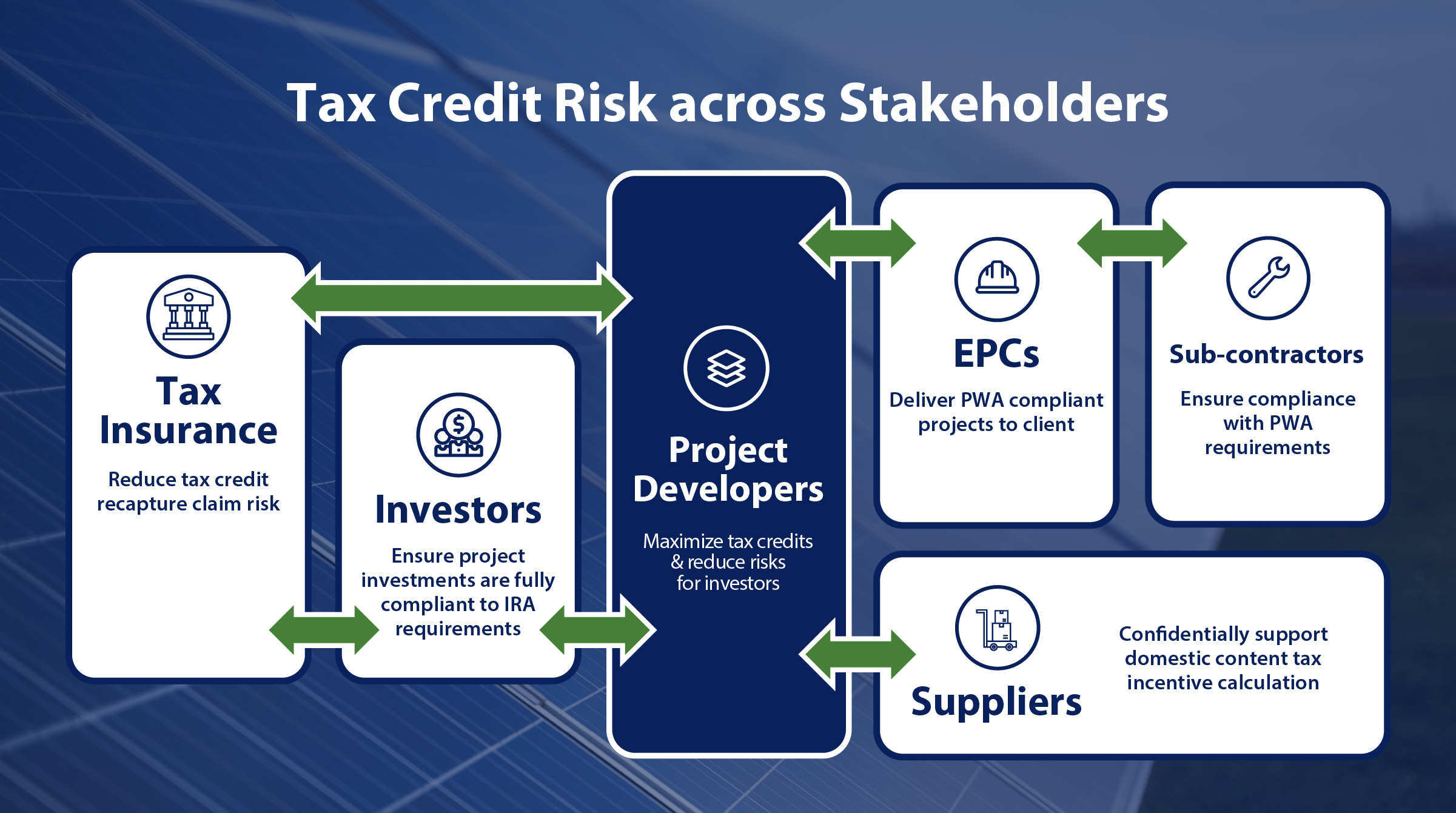Excitement about the IRA continues to surge, with developers and tax credit investors poised to leverage unprecedented growth opportunities while accelerating the country’s clean energy transition. The IRA has attracted $110 billion in private investment and has created close to 100,000 jobs across the U.S.
The key to ensuring expected financial returns from the IRA comes down to a single word: compliance.
Tax credit compliance is fraught with risk and complex to manage. Tax credit investors and transfer buyers, including those utilizing the new T-Flip structures and corporate buyers leveraging tax transfer marketplaces, are all subject to IRA audit risk and the associated tax credit losses and/or expensive non-compliance penalties.
Who holds the risk?
In terms of risk management, tax credit transactions tend to focus on protecting the investor from recapture audit risk, but compliance risks affect the entire clean energy project value chain.

Risks across the value chain:
- Tax credit insurers ultimately hold claim risk, but do not have oversight over EPCs, sub-contractors, or supplier compliance.
- Investors do not have insight into whether or not their investments are compliant with IRA requirements.
- Project developers need to protect investors but don’t have a way of understanding or reporting whether engineering, procurement, and contractors (EPCs), sub-contractors, or suppliers are compliant.
- EPCs can’t guarantee prevailing wage and apprenticeship (PWA) compliance for projects.
- Sub-contractors do not have capabilities to comply with PWA requirements- they rely on contractors for this.
- Suppliers are hesitant to share the confidential cost data required for IRA domestic content compliance.
Risks passed across the chain
What can developers do to mitigate risks? They can provide sponsor indemnifications, require EPC contracts to guarantee PWA compliance, hire an accounting firm to do an AUP (Agreed Upon Procedures) review, and even offer to pay for insurance, but none of these methods fully protect investors. In other words, even with all of these efforts, a tax credit buyer could still fail an IRS recapture audit, which would trigger a cascading set of insurance claims and lawsuits through the entire project value chain.
Risk assessment
Pre-IRA, traditional energy project risk mitigation typically began with a series of questions about a developer’s track record and the project technology size and scope. The questions then focused on an EPC’s history, supplier bankability, and supplier technology risk.
IRA tax credits have created a new, additional layer of risk. Tax credits can be worth 30%, 40%, or even 50% of the value of a project, but need to be protected from IRS recapture audit risk with meticulous proof of compliance throughout a project’s lifecycle.
False comfort
False comfort regarding compliance risk is perhaps the biggest of all.
A tax equity investor or transfer buyer may believe that a contract or an insurance policy mitigates recapture audit risk, when in reality, the investor has significant exposure. These are heightened by four key factors:
1. Unchartered territory: In a typical investment risk assessment, investors have resources like credit rating agencies, historical track records, and market expertise to evaluate internal and external risks. Since guidance on IRA tax credit’ compliance is new and still evolving, investors don’t have the same level of expertise or policies in place to mitigate these new risks.
2. The role of insurance: Because tax equity investors and corporate tax credit transfer buyers assume responsibility post transaction for IRA compliance, it’s common to assume they can use tax credit insurance to cover the risks of IRS audit failure and the resulting loss of tax credits plus any penalties.
However, the market capacity of tax credit insurance is limited, tax credit insurance can be expensive, and insurance companies still expect stakeholders to have some sort of active compliance management in place to reduce risk. In short, insurance companies are not the first line of defense in IRS recapture audit failure.
3. The limitations of accounting practices: Traditional accounting firms typically have limited risk management capabilities for IRA compliance. Because formal audits are prohibitively expensive, they offer AUP reviews, spot checks, and monthly reviews. Still, since they don’t work directly with project EPCs or subcontractors, they can’t sign off on actual compliance for the project PWA requirements.
4. Post-build compliance- Federal PWA requirements extend beyond initial construction phase compliance. Any alterations or repairs throughout the audit recapture period need to meet PWA compliance. Without adequate PWA programs and systems in place to manage operations and maintenance (O&M) contractors, asset management teams can jeopardize tax credits for the entire project.
Tax equity investors and transfer buyers can protect themselves from audit risk and recapture by seeking a platform that was designed specifically for the IRA compliance requirements across the entire project value chain.
The risk management imperative
Tax equity investors and corporate entities utilizing the tax credit transfer market will be held accountable for any error, omission, or lack of compliance from project EPCs and subcontractors. Without an active compliance verification program in place from the onset of a project, investors are taking on significantly more risk than they may understand.
How to approach risk mitigation
Similar to other federal requirements, there are dedicated software platforms designed specifically for IRA compliance. When combined with guidance from compliance experts, they can provide the maximum risk mitigation possible.
To best protect against risk, a single platform should be able to manage all of the intricacies of IRA compliance over the lifecycle of a project. It should be able to ensure compliance for PWA and the adders for domestic content and energy communities. It should also manage compliance for PWA from initial construction to O&M-phase alterations and repairs, and provide protection from recapture audits from the full five year (ITC) or 10 year (PTC) recapture audit periods.
The future of compliance risk management
Investors with the foresight to recognize the risks of IRA non-compliance and require a third-party compliance management system in place prior to construction kick-off will be ahead of the game. By leveraging IRA compliance software and data analytics, investors will be able to fully leverage their IRA tax incentives and reduce their IRS recapture audit failure risk while contributing to a solar-powered, decarbonized future.

Charles Dauber is founder and CEO of Empact Technologies, an IRA compliance management platform. Empact delivers software and services that ensure utility and community-scale project developers and investors are compliant with Prevailing Wage and Apprenticeship, Domestic Content, Energy Community, and Low-Income Community requirements.
The views and opinions expressed in this article are the author’s own, and do not necessarily reflect those held by pv magazine.
This content is protected by copyright and may not be reused. If you want to cooperate with us and would like to reuse some of our content, please contact: editors@pv-magazine.com.








By submitting this form you agree to pv magazine using your data for the purposes of publishing your comment.
Your personal data will only be disclosed or otherwise transmitted to third parties for the purposes of spam filtering or if this is necessary for technical maintenance of the website. Any other transfer to third parties will not take place unless this is justified on the basis of applicable data protection regulations or if pv magazine is legally obliged to do so.
You may revoke this consent at any time with effect for the future, in which case your personal data will be deleted immediately. Otherwise, your data will be deleted if pv magazine has processed your request or the purpose of data storage is fulfilled.
Further information on data privacy can be found in our Data Protection Policy.